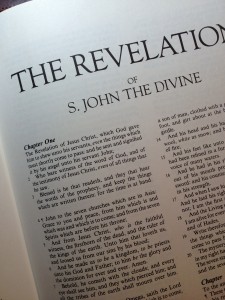The Koine Greek name for the Book of Revelation is apokalupsis from which our English word apocalypse derives, is a word that in the minds of most people conjures up visions of horrific and cataclysmic events in which there is war, political and environmental upheaval involving mass death and destruction. This idea is a misnomer however. Though the Book of Revelation indeed foretells of a cataclysmic end times scenario, the Greek word apokalupsis literally means “laying bear, making naked; a disclosure of truth, instruction concerning things before unknown, manifestation, appearance,” and hence our English name for this book: Revelation. This meaning is made clear in the first verse of this same book.
The Revelation of Yeshua the Messiah, which Elohim gave unto him, to shew unto his servants things which must shortly come to pass; and he sent and signified it by his angel unto his servant John.
The Book of Revelation is just that—a revelation of things to come to pass, which Yeshua is making known to his servants (plural). This includes you and me.
Although, I don’t claim to have all or even much understanding pertaining to this book, I here share with you what I enlightenment I have been given to this point on several key topic. This is simply my understanding to this point until YHVH by his Spirit gives us more understanding. Until then, may we remain as little children, pale in hand, on the seashore of the vast ocean of YHVH’s unfathomable wisdom and knowledge in faith waiting for him to fill our buckets with more of his divine revelation.
What Should Be Our Perspective on the Book of Revelation?
On another note, there are those who champion the view that events of the Book of Revelation are primarily in the past tense. That is to say, Revelation records the events leading up to and following the destruction of the Jewish temple and Jerusalem in A.D. 70. The view that the events of Revelation were mostly fulfilled in the first century is called the preterist view, and those who support this position draw our attention to verses which point to the immediacy of the prophecies of the book being fulfilled—to events which must “shortly take place” (i.e., Rev 1:1, 3; 22:6, 10).
The problems with this view are several. To make it work, most of the prophecies of the book have to be allegorized. As such, preterists believe that little if anything Revelation says can be taken literally. The purpose of Revelation, they say, was to comfort the churches in Asia Minor in light of the persecutions they were enduring (Rev 1:4). While much in Revelation is obviously allegorical, to say that it all is, is simply applying a broad brush approach and, in my opinion, denies some of the basic rules of biblical interpretation. My approach is to take what the book says to be literal, unless the context or passages elsewhere in the Scriptures give us reason to interpret it symbolically.
The second major objection I have to the preterist view is that since most scholars agree that John wrote this book in the last decade of the first century, this view would make John’s Book of Revelation a record of history, as opposed to a prophecy “of things which must shortly come to pass,” which is contrary to the book’s purpose as the first verse of the book clearly states. The preterist view cannot accommodate this reality unless scholars can prove that John wrote all of his book before A.D. 70, a date which is at odds with the records of the early church fathers, which place the date of the books writing in the 90s.
Overview of the Book of Revelation
This book is not the revelation of John, but the “revelation of Yeshua the Messiah” (Rev 1:1). As such, it reveals Yeshua in a variety of ways as indicated in the outline below.
- Rev 1:1–19,The revelation of the resurrected and glorified Yeshua the Savior of mankind.
- Rev 1:20–3:22, The revelation of Yeshua in the midst of his spiritual body — the ecclesia — on this earth.
- Rev 4:1–11, The revelation of Elohim who sits on his throne in glory in heaven. This same Elohim is revealed latter to by synonymous with Yeshua the Lamb. There is one throne in heaven, and one who sits upon it.
- Rev 5:1–10:10; 11:14–18; 15:1–16:21, The revelation of Yeshua the judge.
- Rev 11:1–13, The revelation of the mercy of Yeshua who sends his two witnesses to warn the world one more time before Yeshua pours out his final judgments against wicked men.
- Rev 12:1–17, The revelation of the redeemed Israel out of whom Yeshua the Messiah arose. Satan, Yeshua’s archenemy introduced.
- Rev 13:1–18, The kingdom of Satan introduced, which Yeshua the king will destroy at his second coming.
- Rev 14:1–20, The revelation of Yeshua the Savior of the redeemed righteous and the Just Judge of the wicked.
- Rev 17:1–18:21, More on the end times kingdom of Satan, which opposes itself against Yeshua the king.
- Rev 19:1–20:15, The revelation of Yeshua the king who will destroy Satan and his kingdom, Babylon the Great, and will establish his own kingdom on this earth.
- Rev 21:1–22:21, The revelation of Yeshua in eternity future.
Stay tuned. More on the Book of Revelation to follow…


